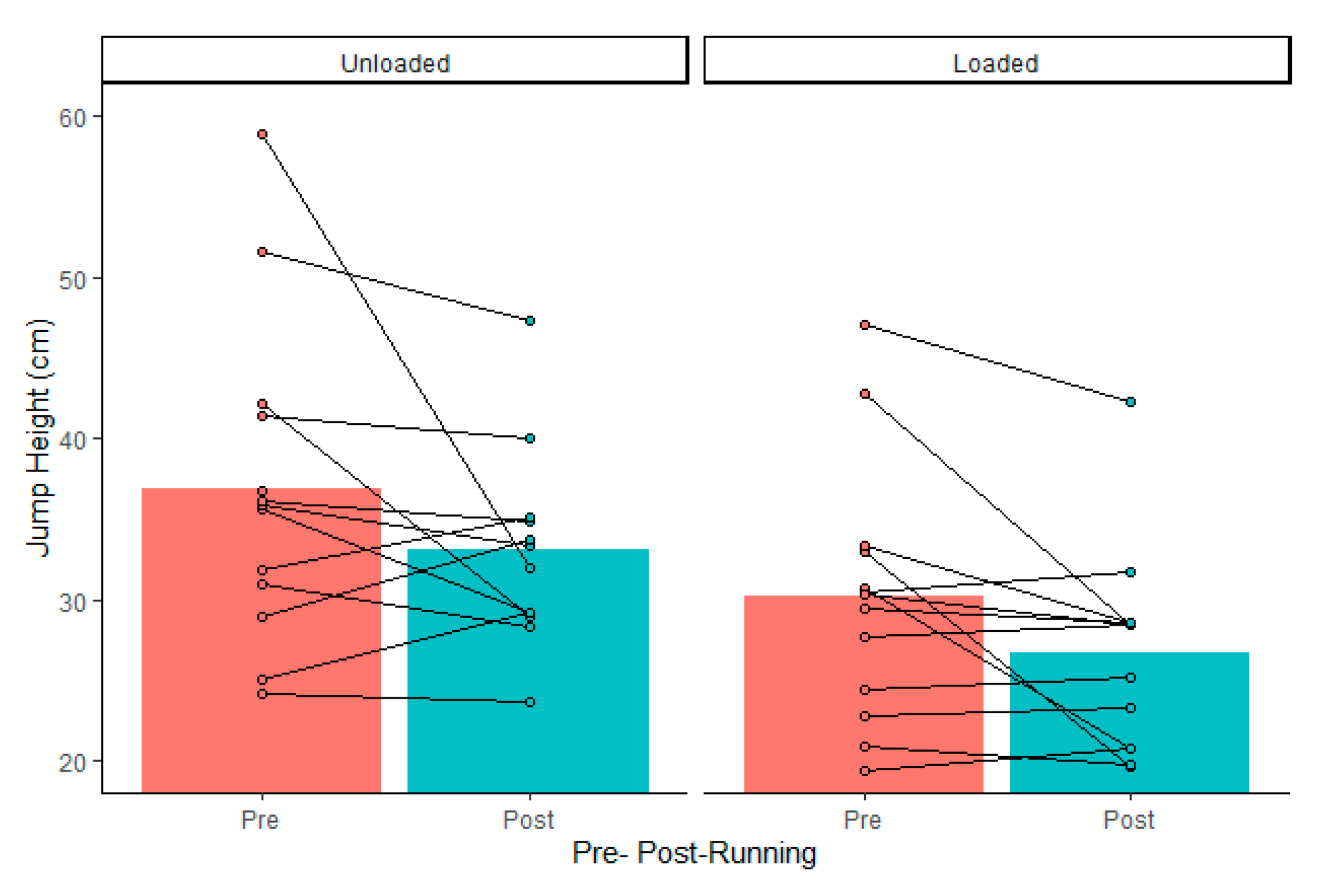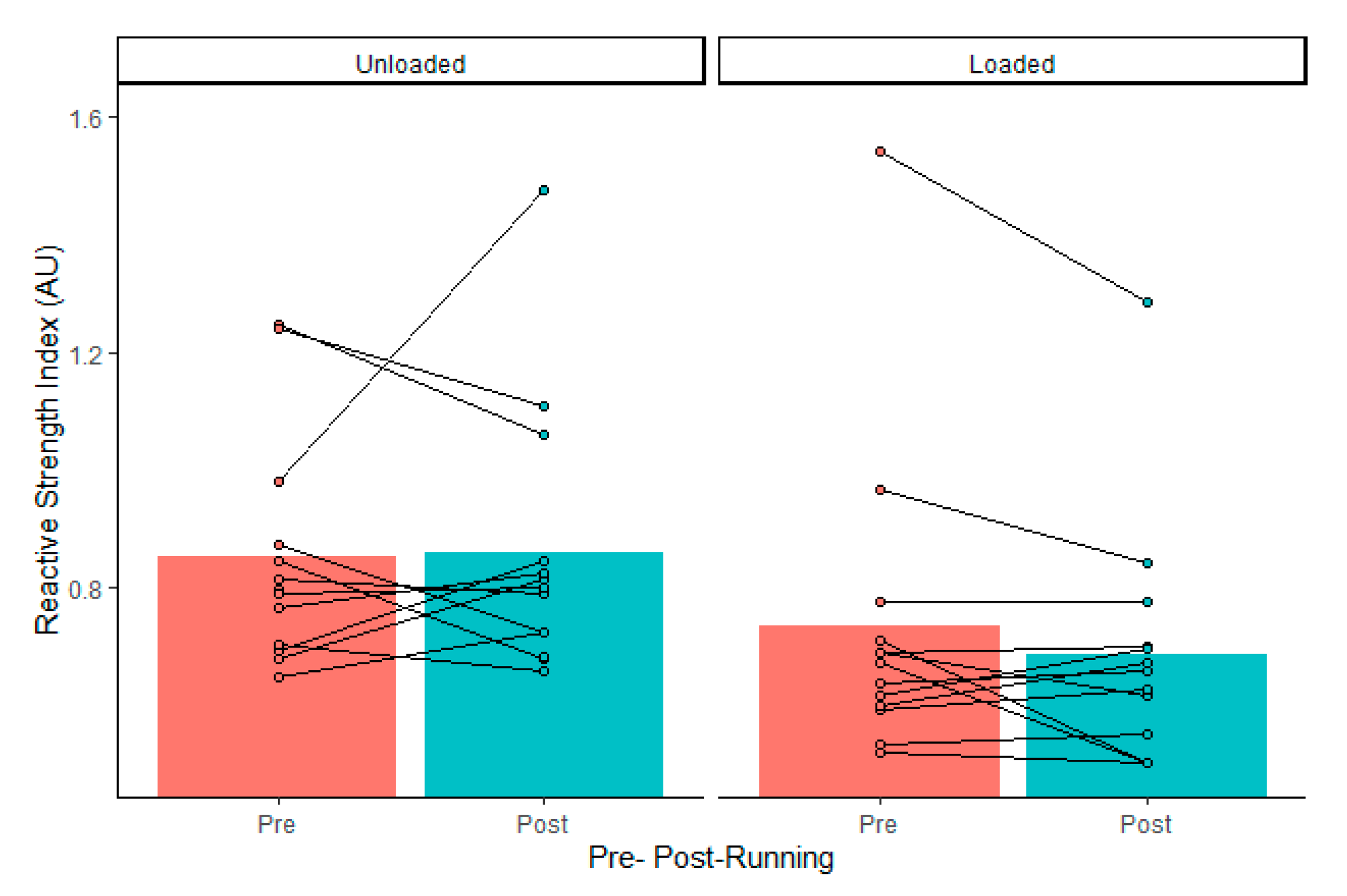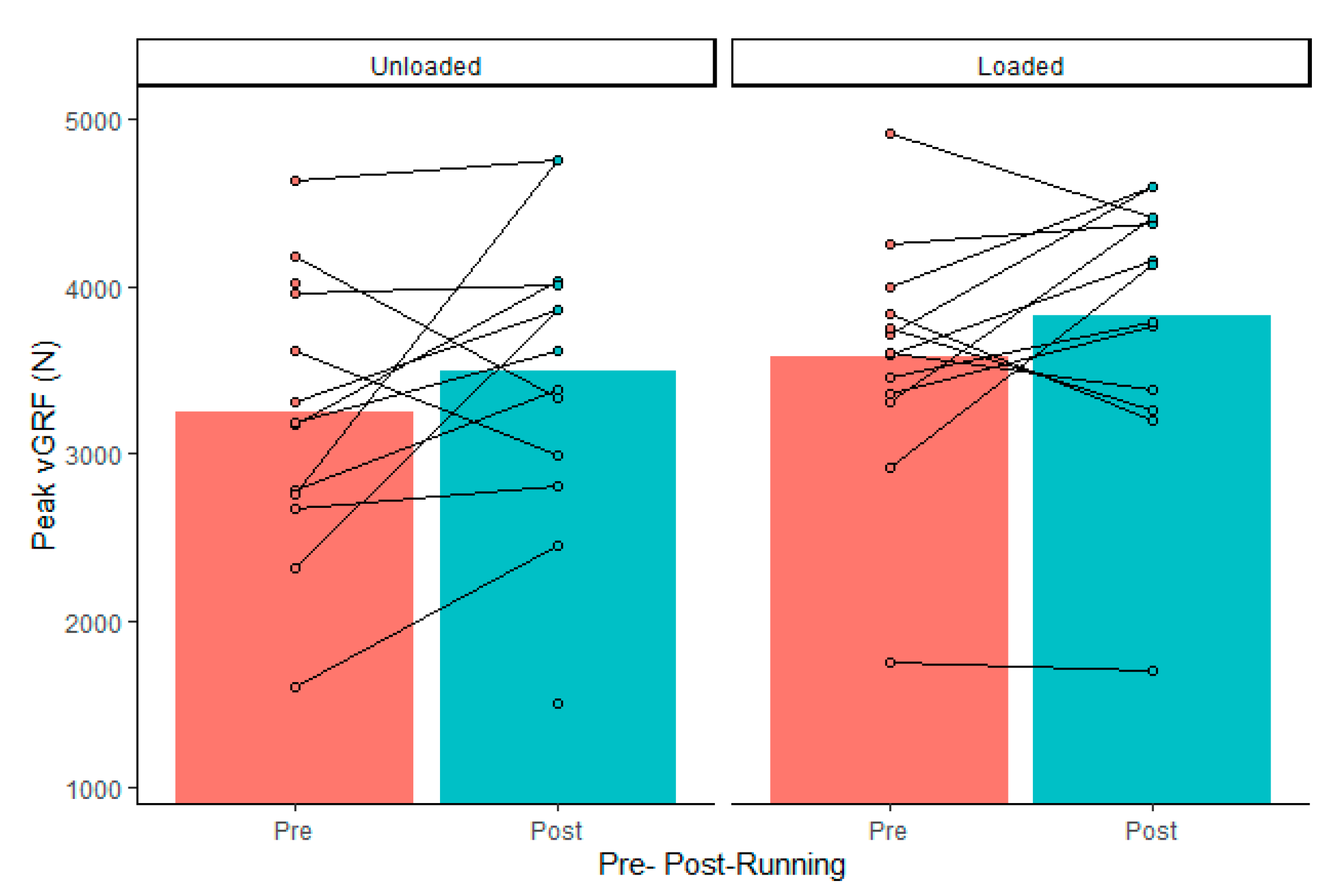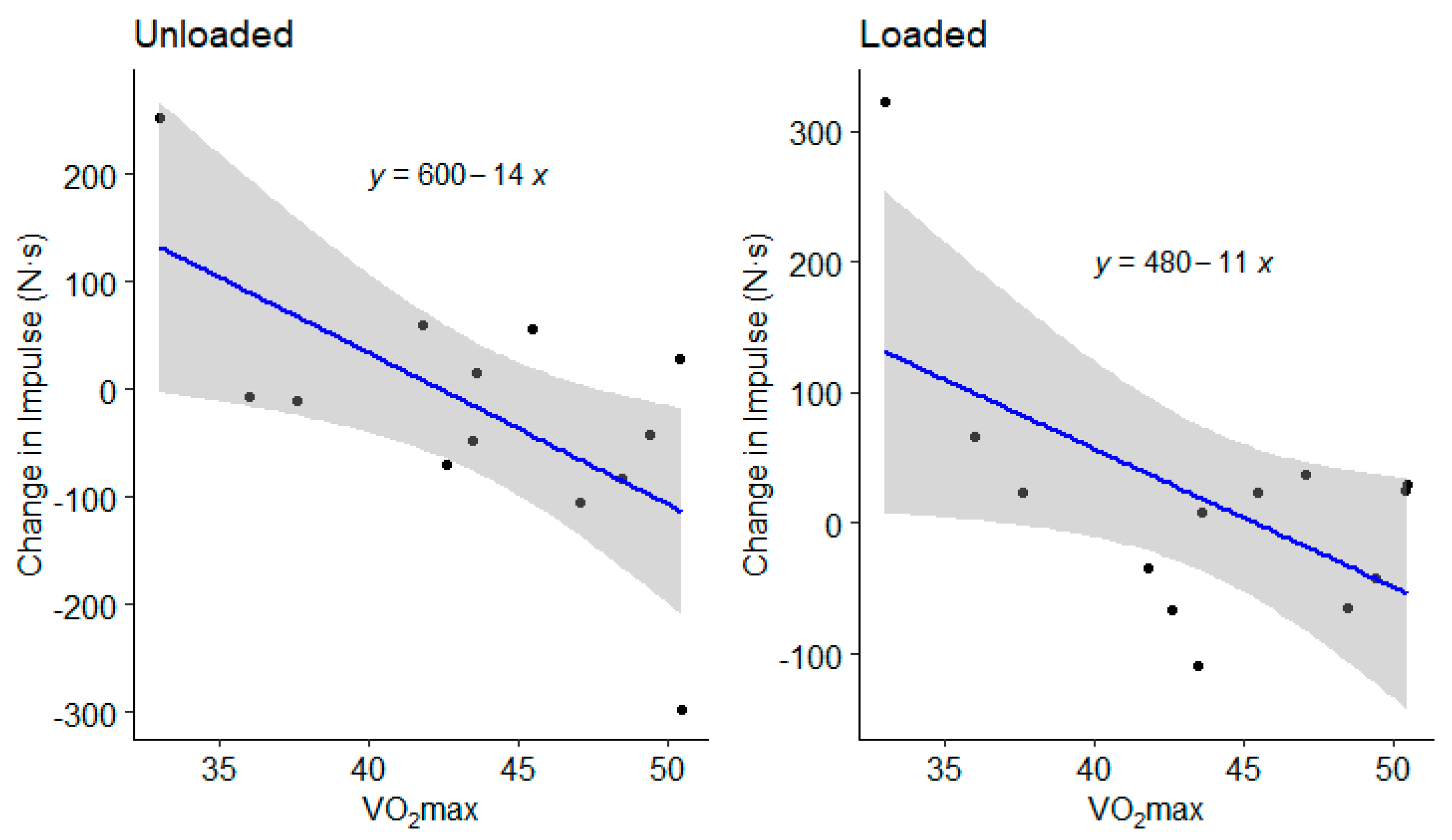Effects of Maximal Effort Running on Special Agents’ Loaded and Unloaded Drop Jump Performance and Mechanics
Abstract
:1. Introduction
2. Materials and Methods
2.1. Subjects
2.2. Design
2.3. Maximal Graded Treadmill Testing
2.4. Drop Jump Testing and Analysis
2.5. Statistical Analysis
3. Results
4. Discussion
Funding
Institutional Review Board Statement
Informed Consent Statement
Data Availability Statement
Acknowledgments
Conflicts of Interest
References
- Knapik, J.J.; Grier, T.; Spiess, A.; Swedler, D.I.; Hauret, K.G.; Graham, B.; Yoder, J.; Jones, B.H. Injury Rates and Injury Risk Factors among Federal Bureau of Investigation New Agent Trainees. BMC Public Health 2011, 11, 920. [Google Scholar] [CrossRef] [Green Version]
- Dijksma, C.I.; Bekkers, M.; Spek, B.; Lucas, C.; Stuiver, M. Epidemiology and Financial Burden of Musculoskeletal Injuries as the Leading Health Problem in the Military. Mil. Med. 2020, 185, e480–e486. [Google Scholar] [CrossRef] [Green Version]
- Lisman, P.; O’connor, F.G.; Deuster, P.A.; Knapik, J.J. Functional Movement Screen and Aerobic Fitness Predict Injuries in Military Training. Med. Sci. Sports Exerc. 2013, 45, 636–643. [Google Scholar] [CrossRef] [Green Version]
- de la Motte, S.J.; Lisman, P.; Gribbin, T.C.; Murphy, K.; Deuster, P.A. Systematic Review of the Association Between Physical Fitness and Musculoskeletal Injury Risk: Part 3—Flexibility, Power, Speed, Balance, and Agility. J. Strength Cond. Res. 2019, 33, 1723–1735. [Google Scholar] [CrossRef] [PubMed]
- Owens, B.D.; Cameron, K.L.; Duffey, M.L.; Vargas, D.; Duffey, M.J.; Mountcastle, S.B.; Padua, D.; Nelson, B.J. Military Movement Training Program Improves Jump-Landing Mechanics Associated With Anterior Cruciate Ligament Injury Risk. J. Surg. Orthop. Adv. 2013, 22, 66–70. [Google Scholar] [CrossRef] [PubMed]
- Nindl, B.C.; Billing, D.C.; Drain, J.R.; Beckner, M.E.; Greeves, J.; Groeller, H.; Teien, H.K.; Marcora, S.; Moffitt, A.; Reilly, T.; et al. Perspectives on Resilience for Military Readiness and Preparedness: Report of an International Military Physiology Roundtable. J. Sci. Med. Sport 2018, 21, 1116–1124. [Google Scholar] [CrossRef] [PubMed] [Green Version]
- Verschueren, J.; Tassignon, B.; De Pauw, K.; Proost, M.; Teugels, A.; Van Cutsem, J.; Roelands, B.; Verhagen, E.; Meeusen, R. Does Acute Fatigue Negatively Affect Intrinsic Risk Factors of the Lower Extremity Injury Risk Profile? A Systematic and Critical Review. Sports Med. Auckl. NZ 2020, 50, 767–784. [Google Scholar] [CrossRef] [PubMed]
- Wang, H.; Frame, J.; Ozimek, E.; Leib, D.; Dugan, E.L. The Effects of Load Carriage and Muscle Fatigue on Lower-Extremity Joint Mechanics. Res. Q. Exerc. Sport 2013, 84, 305–312. [Google Scholar] [CrossRef]
- Merrigan, J.J.; Stone, J.D.; Thompson, A.G.; Hornsby, W.G.; Hagen, J.A. Monitoring Neuromuscular Performance in Military Personnel. Int. J. Environ. Res. Public. Health 2020, 17, 9147. [Google Scholar] [CrossRef]
- Welsh, T.; Alemany, J.; Montain, S.; Frykman, P.; Tuckow, A.; Young, A.; Nindl, B. Effects of Intensified Military Field Training on Jumping Performance. Int. J. Sports Med. 2008, 29, 45–52. [Google Scholar] [CrossRef] [PubMed]
- Merrigan, J.J.; Stone, J.D.; Ramadan, J.; Hagen, J.A.; Thompson, A.G. Dimensionality Reduction Differentiates Sensitive Force-Time Characteristics from Loaded and Unloaded Conditions throughout Competitive Military Training. Sustainability 2021, 13, 6105. [Google Scholar] [CrossRef]
- Merrigan, J.J.; Stone, J.D.; Martin, J.R.; Hornsby, W.G.; Galster, S.M.; Hagen, J.A. Applying Force Plate Technology to Inform Human Performance Programming in Tactical Populations. Appl. Sci. 2021, 11, 6538. [Google Scholar] [CrossRef]
- Kennedy, R.; Drake, D. The Effect of Acute Fatigue on Countermovement Jump Performance in Rugby Union Players during Preseason. J. Sports Med. Phys. Fit. 2017, 57, 1261–1266. [Google Scholar]
- Merrigan, J.J.; O’Toole, K.B.; Wutzke, C.J.; Jones, M.T. A Kinetic and Kinematic Analysis of Various Drop Jump Performances in Army Reserve Officer Training Corps Cadets. J. Strength Cond. Res. 2021, in press. [Google Scholar] [CrossRef] [PubMed]
- Padua, D.A.; DiStefano, L.J.; Beutler, A.I.; de la Motte, S.J.; DiStefano, M.J.; Marshall, S.W. The Landing Error Scoring System as a Screening Tool for an Anterior Cruciate Ligament Injury–Prevention Program in Elite-Youth Soccer Athletes. J. Athl. Train. 2015, 50, 589–595. [Google Scholar] [CrossRef] [Green Version]
- Gokeler, A.; Eppinga, P.; Dijkstra, P.U.; Welling, W.; Padua, D.A.; Otten, E.; Benjaminse, A. Effect of fatigue on landing performance assessed with the landing error scoring system (less) in patients after acl reconstruction. a pilot study. Int. J. Sports Phys. Ther. 2014, 9, 302–311. [Google Scholar] [PubMed]
- Pihlainen, K.; Santtila, M.; Häkkinen, K.; Kyröläinen, H. Associations of Physical Fitness and Body Composition Characteristics With Simulated Military Task Performance. J. Strength Cond. Res. 2018, 32, 1089–1098. [Google Scholar] [CrossRef] [PubMed] [Green Version]
- Tilbury-Davis, D.C.; Hooper, R.H. The Kinetic and Kinematic Effects of Increasing Load Carriage upon the Lower Limb. Hum. Mov. Sci. 1999, 18, 693–700. [Google Scholar] [CrossRef]
- Dempsey, P.C.; Handcock, P.J.; Rehrer, N.J. Body Armour: The Effect of Load, Exercise and Distraction on Landing Forces. J. Sports Sci. 2014, 32, 301–306. [Google Scholar] [CrossRef] [PubMed]
- Orr, R.M.; Pope, R.; Johnston, V.; Coyle, J. Soldier Occupational Load Carriage: A Narrative Review of Associated Injuries. Int. J. Inj. Contr. Saf. Promot. 2014, 21, 388–396. [Google Scholar] [CrossRef] [PubMed]
- Joseph, A.; Wiley, A.; Orr, R.; Schram, B.; Dawes, J.J. The Impact of Load Carriage on Measures of Power and Agility in Tactical Occupations: A Critical Review. Int. J. Environ. Res. Public. Health 2018, 15, 88. [Google Scholar] [CrossRef] [PubMed] [Green Version]
- Jaworski, R.L.; Jensen, A.; Niederberger, B.; Congalton, R.; Kelly, K.R. Changes in Combat Task Performance under Increasing Loads in Active Duty Marines. Mil. Med. 2015, 180, 179–186. [Google Scholar] [CrossRef] [PubMed] [Green Version]
- O’Neal, E.K.; Hornsby, J.H.; Kelleran, K.J. High-Intensity Tasks with External Load in Military Applications: A Review. Mil. Med. 2014, 179, 950–954. [Google Scholar] [CrossRef] [Green Version]
- Yu, P.; Gong, Z.; Meng, Y.; Baker, J.S.; István, B.; Gu, Y. The Acute Influence of Running-Induced Fatigue on the Performance and Biomechanics of a Countermovement Jump. Appl. Sci. 2020, 10, 4319. [Google Scholar] [CrossRef]
- Wong, T.L.; Huang, C.F.; Chen, P.C. Effects of Lower Extremity Muscle Fatigue on Knee Loading During a Forward Drop Jump to a Vertical Jump in Female Athletes. J. Hum. Kinet. 2020, 72, 5–13. [Google Scholar] [CrossRef] [PubMed] [Green Version]
- James, R.C.; Dufek, J.S.; Bates, B.T. Effects of Stretch Shortening Cycle Exercise Fatigue on Stress Fracture Injury Risk During Landing. Res. Q. Exerc. Sport 2006, 77, 1–13. [Google Scholar] [CrossRef]
- Barber-Westin, S.D.; Noyes, F.R. Effect of Fatigue Protocols on Lower Limb Neuromuscular Function and Implications for Anterior Cruciate Ligament Injury Prevention Training: A Systematic Review. Am. J. Sports Med. 2017, 45, 3388–3396. [Google Scholar] [CrossRef]
- Beltz, N.M.; Gibson, A.L.; Janot, J.M.; Kravitz, L.; Mermier, C.M.; Dalleck, L.C. Graded Exercise Testing Protocols for the Determination of VO 2 Max: Historical Perspectives, Progress, and Future Considerations. J. Sports Med. 2016, 2016, 1–12. [Google Scholar] [CrossRef] [Green Version]
- Team, R.C. R: A Language and Environment for Statistical Computing. Available online: https://www.R-project.org (accessed on 6 June 2020).
- Fox, B.D.; Judge, L.W.; Dickin, D.C.; Wang, H. Biomechanics of Military Load Carriage and Resulting Musculoskeletal Injury: A Review. J. Orthop. Orthop. Surg. 2020, 1, 6–11. [Google Scholar]
- Taylor, N.A.S.; Burdon, C.A.; van den Heuvel, A.M.J.; Fogarty, A.L.; Notley, S.R.; Hunt, A.P.; Billing, D.C.; Drain, J.R.; Silk, A.J.; Patterson, M.J.; et al. Balancing Ballistic Protection against Physiological Strain: Evidence from Laboratory and Field Trials. Appl. Physiol. Nutr. Metab. 2016, 41, 117–124. [Google Scholar] [CrossRef] [Green Version]
- Thomas, J.M.; Kollock, R.O.; Hale, W.D.; Long, A.; Bont, A.; Dawes, J.; Sanders, G. Effects of Sex and Load Carried per Kilogram of Body Mass on Landing Technique. Int. J. Exerc. Sci. 2021, 14, 633–643. [Google Scholar]
- Brown, T.N.; O’Donovan, M.; Hasselquist, L.; Corner, B.; Schiffman, J.M. Lower Limb Flexion Posture Relates to Energy Absorption during Drop Landings with Soldier-Relevant Body Borne Loads. Appl. Ergon. 2016, 52, 54–61. [Google Scholar] [CrossRef] [PubMed]
- Dal Pupo, J.; Kons, R.L.; Gheller, R.G.; Costa, F.E.; Vecchia, L.D.; Detanico, D. Neuromuscular Impairment after High-Intensity Running and Vertical Jump Exercise Protocols. Isokinet. Exerc. Sci. 2021, Preprint. 1–7. [Google Scholar] [CrossRef]
- Benjaminse, A.; Webster, K.E.; Kimp, A.; Meijer, M.; Gokeler, A. Revised Approach to the Role of Fatigue in Anterior Cruciate Ligament Injury Prevention: A Systematic Review with Meta-Analyses. Sports Med. 2019, 49, 565–586. [Google Scholar] [CrossRef] [PubMed] [Green Version]





| Unloaded | Loaded | Effect Size (CI 95%) | |
|---|---|---|---|
| Impulse (N∙s) | 1043.4 ± 155.3 | 1242.9 ± 200.0 | 1.115 ± 0.298 (0.51, 1.68) * |
| Peak vGRF (N) | 3369.4 ± 863.5 | 3702.8 ± 766.8 | 0.408 ± 0.280 (−0.15, 0.95) |
| RFD (N∙s−1) | 4191.3 ± 1384.7 | 4171.7 ± 1758.1 | 0.012 ± 0.277 (−0.53, 0.56) |
| Contact Time (s) | 0.638 ± 0.105 | 0.703 ± 0.124 | 0.563 ± 0.283 (0.00, 1.11) * |
| RSI (AU) | 0.858 ± 0.209 | 0.712 ± 0.236 | 0.653 ± 0.284 (0.09, 1.20) * |
| Jump Height (cm) | 34.96 ± 8.24 | 28.40 ± 7.24 | 0.846 ± 0.289 (0.27, 1.40) * |
| LESS (AU) | 5.05 ± 2.73 | 5.38 ± 2.40 | 0.130 ± 0.278 (−0.42, 0.67) |
| Pre | Post | Effect Size (CI 95%) | |
|---|---|---|---|
| Impulse (N∙s) | 1143.7 ± 198.5 | 1142.6 ± 213.1 | 0.006 ± 0.277 (−0.54, 0.55) |
| Peak vGRF (N) | 3411.2 ± 789.5 | 3660.9 ± 857.7 | 0.303 ± 0.279 (−0.25, 0.85) |
| RFD (N∙s−1) | 4416.9 ± 1412.1 | 3946.2 ± 1702.7 | 0.301 ± 0.279 (−0.25, 0.84) |
| Contact Time (s) | 0.675 ± 0.117 | 0.667 ± 0.122 | 0.065 ± 0.277 (−0.48, 0.61) |
| RSI (AU) | 0.794 ± 0.238 | 0.775 ± 0.233 | 0.081 ± 0.277 (−0.46, 0.62) |
| Jump Height (cm) | 33.53 ± 9.45 | 29.84 ± 6.79 | 0.449 ± 0.281 (−0.11, 0.99) |
| LESS (AU) | 4.67 ± 2.65 | 5.77 ± 2.36 | 0.439 ± 0.281 (−0.12, 0.98) |
| Variable | Change | Unloaded # (%) | Loaded # (%) |
|---|---|---|---|
| Impulse | Decrease | 1 (8) | 1 (8) |
| Peak vGRF | Increase | 6 (46) | 6 (46) |
| RFD | Decrease | 7 (54) | 7 (54) |
| Contact Time | Increase | 1 (8) | 2 (15) |
| RSI | Decrease | 4 (31) | 5 (38) |
| Jump Height | Decrease | 3 (23) | 4 (31) |
| LESS | Increase | 7 (54) | 6 (46) |
Publisher’s Note: MDPI stays neutral with regard to jurisdictional claims in published maps and institutional affiliations. |
© 2021 by the author. Licensee MDPI, Basel, Switzerland. This article is an open access article distributed under the terms and conditions of the Creative Commons Attribution (CC BY) license (https://creativecommons.org/licenses/by/4.0/).
Share and Cite
Merrigan, J.J. Effects of Maximal Effort Running on Special Agents’ Loaded and Unloaded Drop Jump Performance and Mechanics. Int. J. Environ. Res. Public Health 2021, 18, 10090. https://doi.org/10.3390/ijerph181910090
Merrigan JJ. Effects of Maximal Effort Running on Special Agents’ Loaded and Unloaded Drop Jump Performance and Mechanics. International Journal of Environmental Research and Public Health. 2021; 18(19):10090. https://doi.org/10.3390/ijerph181910090
Chicago/Turabian StyleMerrigan, Justin J. 2021. "Effects of Maximal Effort Running on Special Agents’ Loaded and Unloaded Drop Jump Performance and Mechanics" International Journal of Environmental Research and Public Health 18, no. 19: 10090. https://doi.org/10.3390/ijerph181910090
APA StyleMerrigan, J. J. (2021). Effects of Maximal Effort Running on Special Agents’ Loaded and Unloaded Drop Jump Performance and Mechanics. International Journal of Environmental Research and Public Health, 18(19), 10090. https://doi.org/10.3390/ijerph181910090






